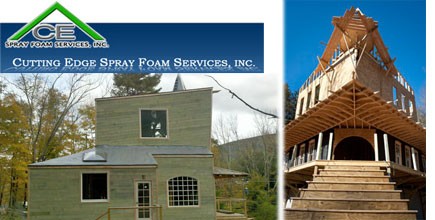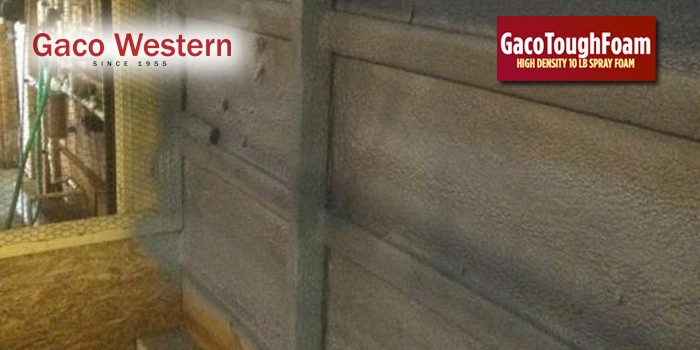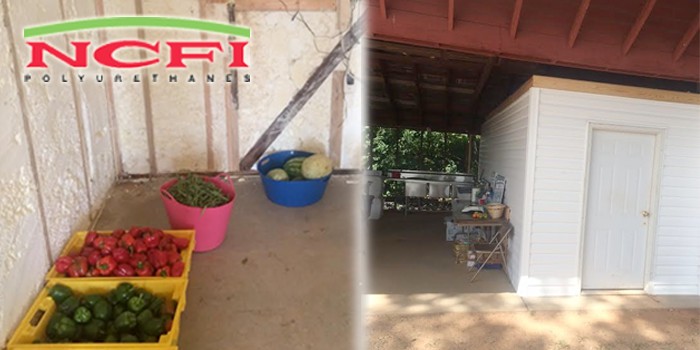
New Home's Unique Roof Makes Job Interesting/Challenging For Applicators
WOODSTOCK, NY – February 4, 2013 – Unique may not even begin to describe the design of a newly constructed home in Woodstock with a roof that was created to emulate a circus tent. The homeowner, who works on television and theater productions, designed the house and constructed it with the aid of a contractor. When it came time to insulate the roof, he contacted Cutting Edge Spray Foam Services, Inc. to create a spray foam roof, an unusual application for a residential property. Although the project was unlike anything Cutting Edge had ever done, they saw it as a unique opportunity and decided to take on the challenge.
The home was constructed on the foundation of a one-story cottage, which was previously destroyed during a fire. According to Douglas Haeberer, Owner and Operator of Cutting Edge, the new property owner already had plans in his head for the design of the residence.
"He explained it to me and sent me over some sketches, so we figured we'd give it a shot," he said.
Among Cutting Edge's project requirements was to create a spray foam roof for the main roof of the structure using mesh wire and a large oil tarp. They also applied closed-cell foam to two smaller roofs as well as to the exterior walls of the home.
For the exterior walls, crewmembers applied three inches of Bayer MaterialScience's BaySeal 2 lb. closed-cell spray foam.
The roofs were a bit more complicated, however. The house had two pitched roofs in the back in addition to the main roof. For aesthetic purposes on the pitched roofs, the homeowner's goal was to see the exposed beams on the underside of the roof decking from the inside of the home. So Cutting Edge applied six inches of foam on top of the tongue and groove decking.
The main roof was designed to give the home a theatrical feel from the interior by using an oil tarp to create the affect. Haeberer said the tarp that was used resembled a circus tent.
A large oil tarp, which was at least 25 ft. x 25 ft., was laid across the area where the roof was to be installed. The tarp, which acted as the roof substrate, was sprayed with Bayer MaterialScience's BaySeal IC ivory, which is a single-component, water-based, intumescent coating designed for application as an ignition barrier. On top of the ignition barrier, crewmembers applied three inches of WDG's 3009-3 3 lb. closed-cell spray foam. To provide structural support for the spray foam roof, wire mesh was laid across the foam then tied into the four perimeter walls of the house. After the wire mesh was in place, crewmembers applied another three inches of spray foam on top of it. To complete the roof, 15 mils of WDG's HSS 535 solvent-free silicone coating was applied to the top layer of foam.
"We had not seen anything like that before," Haeberer said. "It was definitely unique."
In order to access the roof, crewmembers used scaffolding in the back of the house. The main roof had a spire, which was anchored to the exterior walls with three cables. Each worker was tied off to the spire with ropes and wore harnesses for safety purposes.
"It was a fun project, but a little scary," said Haeberer. "We had to tie in and the whole nine yards. We had to get into our harnesses in order to do it."
Haeberer also added that the roof was sometimes slick due to the silicone, so the workers had to use extreme caution.
"Silicone got on my heel and when I stepped down, my foot went out from under me," he said. "Next thing I knew, I was sitting in a big puddle of silicone. Tying in saved me on that one – I would've just slid off the roof. Sometimes guys don't want to tie in. I'm living proof that if I didn't, I would have slid right off that roof."
Crewmembers used North fresh air supply full-face masks while spraying the walls indoors and North full-face masks with canisters while spraying outdoors.
Plastic sheeting was used indoors and outdoors to protect the windows from overspray. Crewmembers also had to cover a two-foot perimeter area where the roof had been exposed. Exterior walls were draped with plastic in case wind became an issue. No other trades were present at the home while spraying took place.
It took three crewmembers, including Haeberer, about a week to complete the project in the fall of 2012. The total spray area was just under 3,500 square feet. Crewmembers used a Graco H-20/30 Pro to complete the job.
The homeowner has been satisfied with the new insulation. Since the application, the structure has survived numerous rainstorms, as well as Superstorm Sandy, with no issues. According to Haeberer, the house continues to draw a lot of attention from passers-by.
"To this day, we drive past it and guaranteed somebody's stopped to look at it," he said. "What these guys did was incredible. Two guys built the whole house with the exception of the roofing system."
About Cutting Edge Spray Foam Services, Inc.: Cutting Edge offers quality service for energy efficient and effective insulation systems. The company provides closed-cell and open-cell foam applications as well as pour foam applications. Cutting Edge specializes in ignition and thermal barriers and offers closed-cell roofing for flat roofs with acrylic, silicone and polyurea coatings, open and closed-cell spray foam, open and closed-cell pour foam, interior wall soundproofing, cold storage facility application, rim joists application, crawlspace encapsulation, and doggie foam domes/igloos. For more information about Cutting Edge Spray Foam Systems, Inc., please use the contact details and links provided below.













